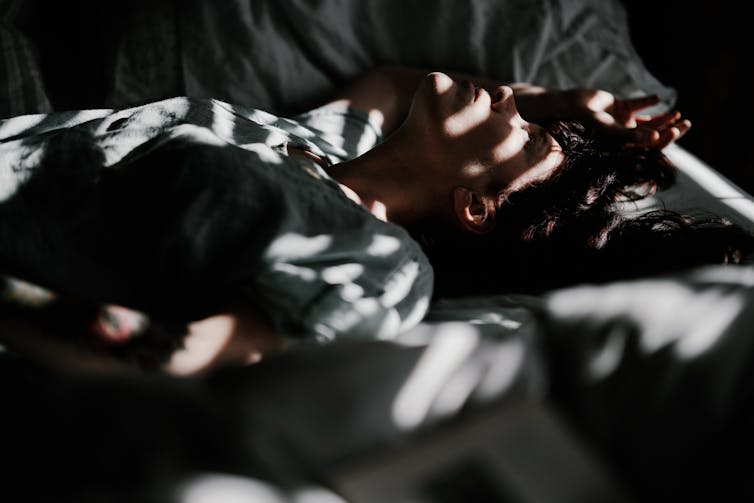In summary
Analysis for The Conversation by Senior Lecturer in Psychology Dr Simone Buzwell and PhD candidate Eva Johansen, Swinburne University of Technology
When a comic about “mental load” went viral in 2017, it sparked conversations about the invisible workload women carry. Even when women are in paid employment, they remember their mother-in-law’s birthday, know what’s in the pantry and organise the plumber. This mental load often goes unnoticed.
Women also continue to do more housework and childcare than their male partners.
This burden has been exacerbated over the recent pandemic (homeschooling anyone?), leaving women feeling exhausted, anxious and resentful.
As sexuality researchers, we wondered, with all this extra work, do women have any energy left for sex?
We decided to explore how mental load affects intimate relationships. We focused on female sexual desire, as “low desire” affects more than 50% of women and is difficult to treat.
Our study, published in the Journal of Sex Research, shows women in equal relationships (in terms of housework and the mental load) are more satisfied with their relationships and, in turn, feel more sexual desire than those in unequal relationships.
How do we define low desire?
Low desire is tricky to explore. More than simply the motivation to have sex, women describe sexual desire as a state-of-being and a need for closeness.
Adding to this complexity is the fluctuating nature of female desire that changes in response to life experiences and the quality of relationships.

Low desire is more than just the motivation to have sex. Annie Spratt/Unsplash
Relationships are especially important to female desire: relationship dissatisfaction is a top risk factor for low desire in women, even more than the physiological impacts of age and menopause. Clearly, relationship factors are critical to understanding female sexual desire.
As a way of addressing the complexity of female desire, a recent theory proposed two different types of desire: dyadic desire is the sexual desire one feels for another, whereas solo desire is about individual feelings.
Not surprisingly, dyadic desire is intertwined with the dynamics of the relationship, while solo desire is more amorphous and involves feeling good about yourself as a sexual being (feeling sexy), without needing validation from another.
Assessing the link
Our research acknowledged the nuances of women’s desire and its strong connection to relationship quality by exploring how fairness in relationships might affect desire.
The research involved asking 299 Australian women aged 18 to 39 questions about desire and relationships.
These questions included assessments of housework, mental load – such as who organised social activities and made financial arrangements – and who had more leisure time.
We compared three groups:
- relationships where women perceived the work as equally shared equal (the “equal work” group)
- when the woman felt she did more work (the “women’s work” group)
- when women thought that their partner contributed more (the “partner’s work” group).
We then explored how these differences in relationship equity impacted female sexual desire.
What we found
The findings were stark. Women who rated their relationships as equal also reported greater relationship satisfaction and higher dyadic desire (intertwined with the dynamics of the relationship) than other women in the study.
Unfortunately (and perhaps, tellingly), the partner’s work group was too small to draw any substantial conclusions.
However, for the women’s work group it was clear their dyadic desire was diminished. This group was also less satisfied in their relationships overall.

Women who perceived they did more work in the relationship felt less sexual desire. Lucaxx Freire/Unsplash
We found something interesting when turning our attention to women’s solo desire. While it seems logical that relationship inequities might affect all aspects of women’s sexuality, our results showed that fairness did not significantly impact solo desire.
This suggests women’s low desire isn’t an internal sexual problem to be treated with mindfulness apps and jade eggs, but rather one that needs effort from both partners.
Other relationship factors are involved. We found children increased the workload for women, leading to lower relationship equity and consequently, lower sexual desire.
Relationship length also played a role. Research shows long-term relationships are associated with decreasing desire for women, and this is often attributed to the tedium of over-familiarity (think of the bored, sexless wives in 90s sitcoms).
However our research indicates relationship boredom is not the reason, with the increasing inequity over the course of a relationship often the cause of women’s disinterest in sex.
The longer some relationships continue, the more unfair they become, lowering women’s desire. This may be because women take on managing their partner’s relationships, as well as their own (“It’s time we had your best friend over for dinner”).
And while domestic housework may start as equally shared, over time, women tend to do more household tasks.
What about same-sex couples?
Same-sex couples have more equitable relationships.
However, we found the same link between equity and desire for women in same-sex relationships, although it was much stronger for heteronormative couples.
A sense of fairness within a relationship is fundamental to all women’s satisfaction and sexual desire.
What happens next?
Our findings suggest one response to low desire in women could be to address the amount of work women have to take on in relationships.
The link between relationship satisfaction and female sexual desire has been firmly established in previous research but our findings explain how this dynamic works: women’s sense of fairness within a relationship forecasts their contentment, which has repercussions on their desire for their partner.
To translate our results into clinical practice, we could run trials to confirm if lowering women’s mental load results in greater sexual desire.
We could have a “housework and mental load ban” for a sample of women reporting low sexual desire and record if there are changes in their reported levels of desire.
Or perhaps women’s sexual partners could do the dishes tonight and see what happens.
This article was originally published on The Conversation.
-
Media Enquiries
Related articles

- Social Affairs
Swinburne students find ‘no evidence’ for electronic monitoring of youth offenders
Swinburne undergraduate students have evaluated whether electric monitoring practices align with legal standards and human rights.

- Social Affairs
- Politics
New Swinburne Report Exposes How Australia’s Child Support System Enables Financial Abuse, Fuelling Child Poverty
A new Swinburne research report presented in Parliament House details how child support is being weaponised against single mothers and their children.

- Social Affairs
‘Overwhelmed, hopeless, crushed’: Swinburne report reveals how housing crisis is reshaping young people’s lives
Australia’s housing crisis is severely impacting young people’s safety, relationships, health and wellbeing, education, employment, and ability to plan for the future, according to new report.

- Social Affairs
New Swinburne research highlights older Australians falling through the cracks of housing crisis
More than half a million Australians aged 55 or over are at risk of falling through the cracks of housing security, according to a new Swinburne report.

- Social Affairs
- Sustainability
“This approach had heart”: local, people-centred response to regional flood recovery the way forward, Swinburne report finds
Bringing together local organisations to help communities impacted by floods creates long lasting and positive impacts, according to a new report by Swinburne University of Technology
-

- Social Affairs
Swinburne students find ‘no evidence’ for electronic monitoring of youth offenders
Swinburne undergraduate students have evaluated whether electric monitoring practices align with legal standards and human rights.
Monday 21 October 2024 -

- Social Affairs
- Politics
New Swinburne Report Exposes How Australia’s Child Support System Enables Financial Abuse, Fuelling Child Poverty
A new Swinburne research report presented in Parliament House details how child support is being weaponised against single mothers and their children.
Tuesday 08 October 2024 -

- Social Affairs
‘Overwhelmed, hopeless, crushed’: Swinburne report reveals how housing crisis is reshaping young people’s lives
Australia’s housing crisis is severely impacting young people’s safety, relationships, health and wellbeing, education, employment, and ability to plan for the future, according to new report.
Thursday 10 October 2024 -

- Social Affairs
New Swinburne research highlights older Australians falling through the cracks of housing crisis
More than half a million Australians aged 55 or over are at risk of falling through the cracks of housing security, according to a new Swinburne report.
Wednesday 16 October 2024 -

- Social Affairs
- Sustainability
“This approach had heart”: local, people-centred response to regional flood recovery the way forward, Swinburne report finds
Bringing together local organisations to help communities impacted by floods creates long lasting and positive impacts, according to a new report by Swinburne University of Technology
Thursday 15 August 2024


